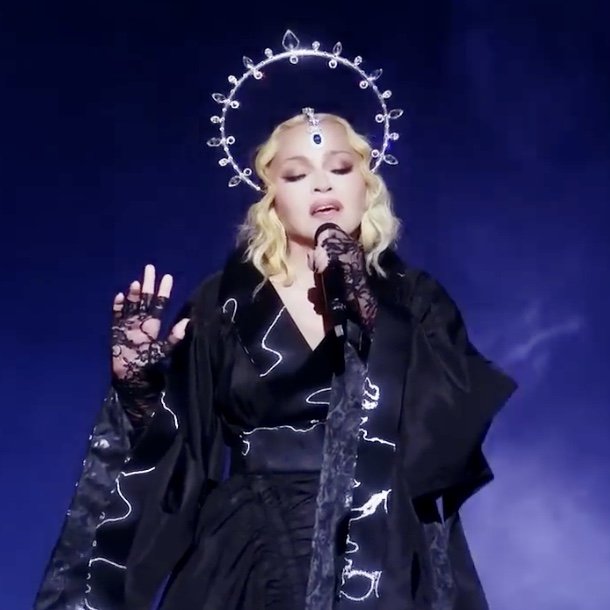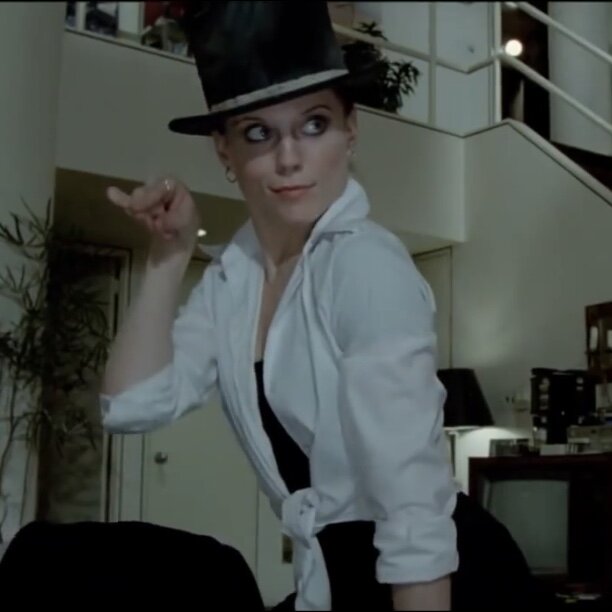Tour de Force: Five Madonna-Concert Faves
To commemorate her 40 years in the music industry, Madonna recently embarked upon her Celebration Tour, essentially a greatest-hits tour that also affords the Queen of Pop the opportunity to perform fan-favorite singles she hasn’t performed in a live-concert setting. One such track is “Nothing Really Matters,” her epiphanic Ray of Light reflection on love, and the cyclical nature of karma. The latter is smartly conveyed through stage design (rotating platforms; circular lighting rig) and costume (halo headdress; spherical cutouts in her “Frozen”-inspired gothic gown). This particular performance captures some of the signature elements that go hand in hand with a Madonna tour: music, fashion and (performance) art.
Throughout her peerless career, she has set out on a number of world tours. Granted I haven’t seen every one of them, but I am grateful to have attended five Madonna concerts (Drowned World; Reinvention; Confessions; Sticky & Sweet; MDNA), two of which make the list of my five favorite Madonna tours, while the other three on the list have been watched a number of times on VHS, Blu-Ray, and cable TV, and still serve as ones I wish I could’ve attended. “And it goes something like this”:
You Always Remember Your First: Madonna set out on her debut tour with 1985’s The Virgin Tour, with a setlist composed of tracks from her self-titled album, and her second album, Like a Virgin. Her Detroit, Michigan stop was the setting for the concert film, Madonna Live: The Virgin Tour. Throughout the 55-minute film, she exuded raw talent, and within minutes, it was evident she was doing exactly what she was meant to do: dance and sing (“get up and do your thing”). Although, at times, there’s evidence of a backing track, Madonna takes full ownership of her voice, and performed the vigorous choreography without gasping for air, tangling a rosary, or dropping a tambourine.
Towards the end of the opening number, “Dress You Up,” Madonna struts, then partially removes her multi-colored jacket to reveal her purple lace blouse. A confident star in born. Yet in keeping with the virgin theme, that confidence is offset by a moment of authentic innocence, revealed during an interlude in the second number, “Holiday,” when she becomes visibly moved by the realization that this hometown girl did good. “You know, I was never elected the homecoming queen or anything, but I sure feel like one now!” Another performance I tend to watch often: the Like a Virgin rarity, “Over and Over,” which featured her sporting teased hair and thrift-store-style fringe, with ‘60s go-go choreography at every step. The track includes the prophetic lyric for the ever-determined Madonna: “You try to criticize my drive/If I lose, I don’t feel paralyzed.”
Act of Ambition: Her most theatrical, and controversial, show to date, Madonna’s 1990 Blond Ambition World Tour was a rallying cry against ‘80s conservatism that could easily be summed up in two simple words: express yourself. And she, and her corps of dancers, did just that during a show that pushed buttons and purposely pushed the envelope. When “Causing a Commotion” turned 30, I wrote a post about this third song in the tour setlist. It’s one of the best in the show, for it captures some of the elements that make the Blond Ambition Tour so iconic. For starters, the show is style with sociological substance. To read more, click here.
I Dream of Androgyny: If one thought Madonna couldn’t get any more controversial with the Blond Ambition World Tour, in 1992 she released her Erotica album, and the art-core coffee-table book, Sex. A year later, she launched The Girlie Show. Madonna’s platinum-blond pixie cut was the antithesis of the robo-ponytail that she sported on her previous tour, allowing her to blur the lines between conventional female and male. The four female dancers, who also embraced an androgynous aesthetic, each with short, boyish haircuts, served as doppelgängers of their male-dancer counterparts.
The show, set amid a cabaret-carnival theme, featured some of Madonna’s best live vocals, particularly during the fourth track in the setlist, “Rain.” The performance put heavenly three-part harmony centerstage, thanks in part to backing vocalists, Donna De Lory and Niki Haris. It gets even more soothing with the inclusion of The Temptations’ “Just My Imagination” in the already beautiful bridge. The lyric in “Rain,” along with a corresponding golden-yellow lighting cue: “Here’s comes the sun/And I say never go away” also signified the transition from the dark “Dominatrix” section to the forthcoming Studio 54-inspired section, commencing with a disco/funk version of “Express Yourself.” It’s one of those goosebump moments brought about by Victor Bailey’s bass-synthesizer, Paul Pesco’s guitar scratch, Omar Hakim at the kit, the red curtain rising, the organ keys, those percolating electro-disco blips, and Madonna sliding off a gigantic mirror ball to begin the chorus.
While parts of the show move a bit slow (“Like A Virgin” as an homage to Marlene Dietrich; a long “Holiday” that overstays its welcome; an Alice In Wonderland fever dream that is “Justify My Love”), Madonna ends on an upbeat note for the last song, “Everybody,” as the way to introduce her band members. (Her introduction of the aforementioned bass player, Victor Bailey is one of my favorite moments in any Madonna concert.) She also mashes up the second verse from Sly & The Family Stone’s “Everybody is a Star” into the beginning of this funky finale.
Pop as Punk: By 2001, Madonna hadn’t toured in 8 years. During that time, she starred in the Alan Parker movie-musical, Evita, gave birth to her daughter, Lourdes, and recorded and released her masterpiece that is Ray of Light. One year into the new millennium, Madonna set out on her Drowned World Tour to further support the already successful Ray of Light album. The opening section donned an English punk-rock sound and vision, with the audience seeing and hearing Madonna play electric guitar live on “Candy Perfume Girl,” followed by a cheeky ‘60s-pop performance of “Beautiful Stranger,” the song she contributed to the Austin Powers: The Spy Who Shagged Me soundtrack.
The fiery red “Geisha Girl” section saw Madonna reversing the conventional submissive role to one of a dominant warrior, complete with aerial acrobatics. The “Country Girl” chapter allowed the audience once again to see her strum her guitar on “I Deserve It” and “Secret,” and later on “La Isla Bonita” during the “Spanish Girl” section. But it’s the finale that featured “ghetto-fabulous” performances of “Holiday” and “Music” that showcased Madonna’s mind-blowing ability to dig deep and deliver strength at the end of an already physically demanding show. (The first time seeing Madonna was during this tour, on a stop in Oakland, CA.)
I Must Confess: The 2005 Confessions on a Dance Floor era was Madonna’s return to (‘70s disco) dance-pop. In 2006, she launched her taut Confessions Tour, which incorporated a gigantic mirror ball that descended from the rafters to open the show. This iconic symbol cracked open like a crystal-encrusted egg, and hatched the icon herself, dressed in an English-equestrian outfit, complete with a riding crop used as a “dominant” double entendre. “Future Lovers” mashed up with Donna Summer’s “I Feel Love” set the modern-day disco tone, followed by “Get Together,” then a remarkable remix of “Like a Virgin,” performed with physical prowess on a merry-go-round-inspired cowboy saddle, with a powerhouse parkour-heavy performance of “Jump” to conclude the opening section.
Later, religion, rock n’ roll, and roller skates also play roles in this brilliant show, which concluded with her ABBA (“Gimme! Gimme! Gimme!”)-sampled hit at the time, “Hung Up.” (I had the pleasure of attending a tour stop in San Jose, CA.)
These five concerts alone easily cement Madonna as the greatest female entertainer, who for three decades was certainly a (tour de) force to be reckoned with.
Photo 1: Live Nation; 2: Warner Music, Sire Records; 3: Blond Ambition World Tour - Yokohama; 4: Warner Reprise Video, Maverick, Sire; 5: Warner Music Vision, Warner Reprise Video, Maverick; 6: Warner Bros., Warner Music Vision.
Plié Your Respects: Ann Reinking, Angels and All That Jazz
The dancer, actress and choreographer, Ann Reinking had a professional, and throughout most of the ’70s, a personal relationship with choreographer, Bob Fosse. In his semi-autobiographical film fantasy, All That Jazz, Reinking was perhaps at her most inspiring. As Kate Jagger (essentially playing herself), she delivered convincingly (perhaps pulling from an all-too-familiar reality) an exhausted, heartfelt plea to Roy Scheider’s philandering Joe (Bob Fosse) Gideon: “I don’t wanna go out with Michael Graham, I don’t wanna date, I have no more small talk left. I don’t wanna fool around, I don’t wanna play games, and I don’t wanna fight, I just… want… to love you.”
Although Joe is callous about casual sex, wound up about work and lousy at love, Kate remains ever-supportive, even continuing to serve as surrogate older sister/guardian (angel) to Joe’s daughter, Michelle (Erzsébet Földi, playing Nicole Fosse, daughter of Bob Fosse and fellow dance legend, Gwen Verdon). After Joe receives less-than-stellar early reviews on his new film, The Standup, Kate and Michelle as “those two dancing sensations, Jagger and Gideon” express through “an unrehearsed tribute” how much they love Joe, regardless of the “el stink-o, el flop-o” critiques.
It’s here where Kate is the angelic light, displaying exuberance and elegance, even providing nurturing notes to Michelle mid-routine. And as Peter Allen’s “Everything Old is New Again” comes to a close, a stressed-out Joe forgets his troubles, and gets happy, well, displays a rare smile. It’s a fleeting moment of joy for him—and the audience—as Fosse quickly cuts the scene and puts Joe back in his familiar morning-hangover routine of Visine and Dexedrine, starting another dark day that’s sure to be filled with issues of self-worth, the futile pursuit of perfection, and self-destruction.
Later however, in one of Joe’s “hospital hallucinations,” Kate is as an angel of death of sorts, but one bedazzled in a black sequined bowler hat, high-cut leotard and tights nonetheless (a seductive Odile [the black swan] to her previous innocent Odette [the white swan] in a razzle-dazzle rendition of Tchaikovsky’s Swan Lake). In “There’ll Be Some Changes Made,” Kate warns Joe that the proverbial final curtain is about to come down if he keeps singing and dancing to the same ol’ tune. The light, in more ways than one, is about to go out.
As only Fosse (and Gideon) could do—as a director controlling how things should appear and move about—Joe imagines his death as one sparkly, soulful, acid-rock finale to life; in the audience are people from his past, including Kate, sitting next to who we can assume is Michael Graham, the dancer she references earlier in the film. Fosse respected Reinking and her talent so much that she is also cast here as one of the “anatomy angels” who dances alongside Joe and “death emcee,” O’Connor Flood (Ben Vereen). Joe takes his final bow, and in a dolly shot floats toward another light throughout the movie, Angelique, the film’s true angel of death (played by Jessica Lange, Fosse’s romantic interest at the time); leave it to Fosse to fantasize that death is a flirty female.
After the end credits, it wasn’t the end for Reinking, who appeared in the film version of the Broadway musical, Annie, and as Micki in the comedy, Micki & Maude. In the late ‘90s, she starred in and choreographed the revival of Chicago on Broadway, which earned her a Tony Award for Best Choreography, and later co-created, -directed and -choreographed the musical retrospective, Fosse. With Gwen Verdon’s passing in 2000, Reinking became one of the major torchbearers of Fosse’s artistic legacy, until December 12, 2020 when she passed away in her sleep, a graceful exit to join the angels.
All That Jazz cinematographer: Guiseppe Rotunno.











